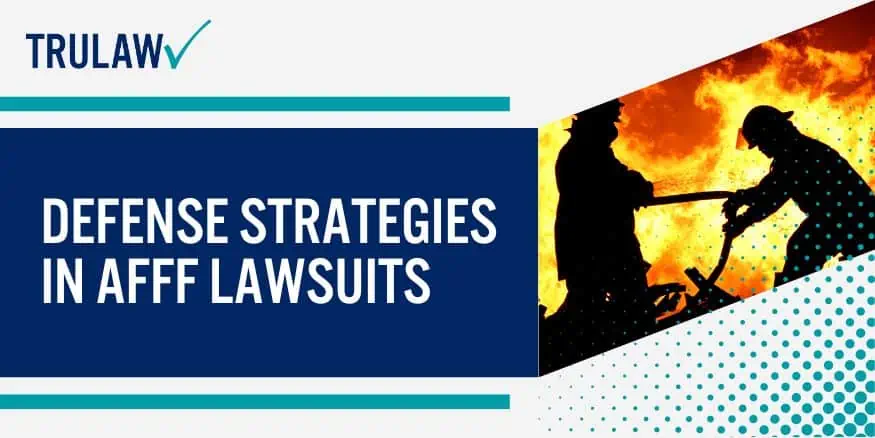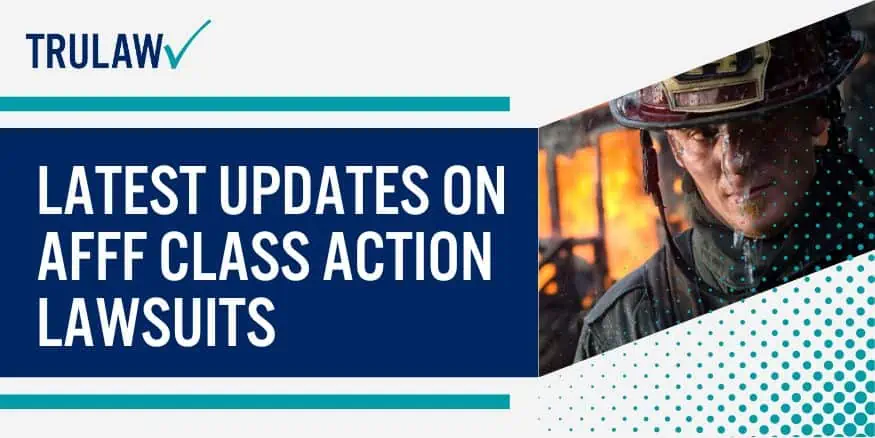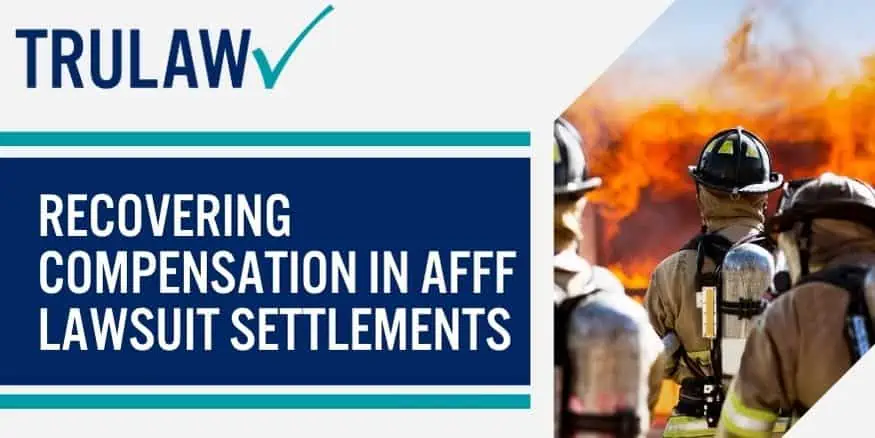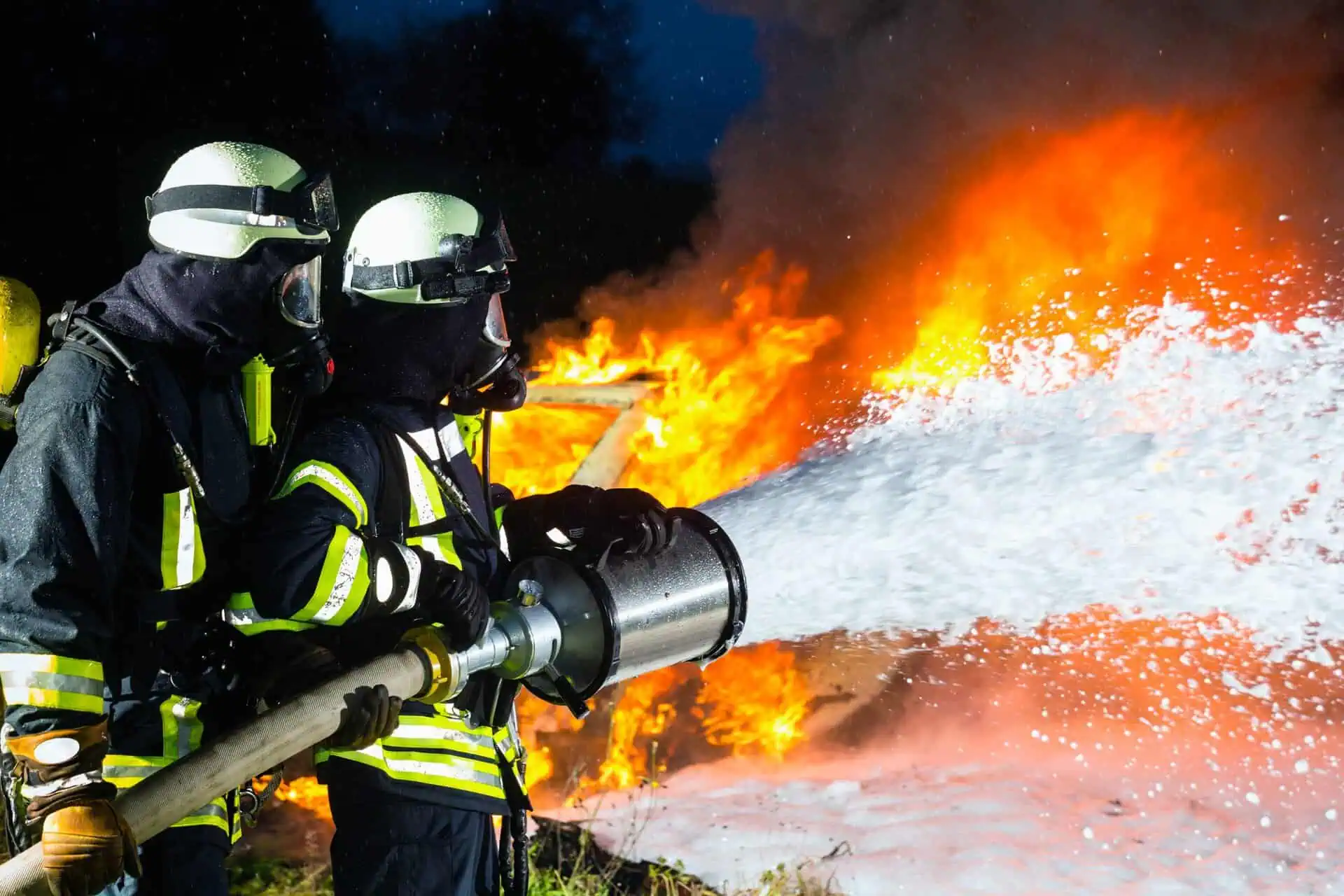AFFF Lawyer: Hiring Process Factors You Should Know
- Last Updated: July 14th, 2025

Attorney Jessica Paluch-Hoerman, founder of TruLaw, has over 28 years of experience as a personal injury and mass tort attorney, and previously worked as an international tax attorney at Deloitte. Jessie collaborates with attorneys nationwide — enabling her to share reliable, up-to-date legal information with our readers.
Legally Reviewed
This article has been written and reviewed for legal accuracy and clarity by the team of writers and legal experts at TruLaw and is as accurate as possible. This content should not be taken as legal advice from an attorney. If you would like to learn more about our owner and experienced injury lawyer, Jessie Paluch, you can do so here.
Fact-Checked
TruLaw does everything possible to make sure the information in this article is up to date and accurate. If you need specific legal advice about your case, contact us by using the chat on the bottom of this page. This article should not be taken as advice from an attorney.
Key takeaways:
- When hiring an AFFF lawyer, consider their experience and expertise in handling AFFF and military firefighting cases.
- Also, consider the lawyer's reputation, professionalism, and ability to communicate effectively.
- AFFF lawsuits require different defense strategies for each case.
AFFF Lawyer: Hiring Process Factors You Should Know
AFFF lawyers specialize in handling cases involving government contractors, training exercises, and military-related matters, including those related to the air force.
They have a deep understanding of the relevant laws and regulations and can assist you in building a strong case.
When hiring an AFFF lawyer, consider their experience and expertise in handling AFFF and military firefighting cases.
Look for a lawyer with a successful track record and knowledge of the unique challenges involved.
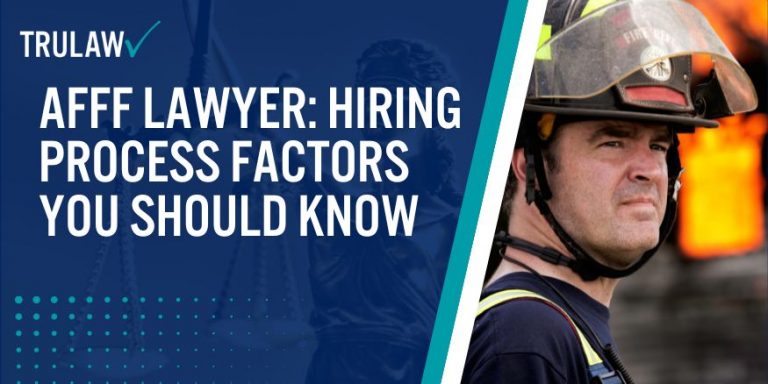
Also, consider the lawyer’s reputation, professionalism, and ability to communicate effectively.
It’s important to feel comfortable and confident in their abilities.
Discuss the fees and payment structure with the attorney before hiring them.
Understand the costs involved and how they charge for their services.
Table of Contents
AFFF and Cancer Connection
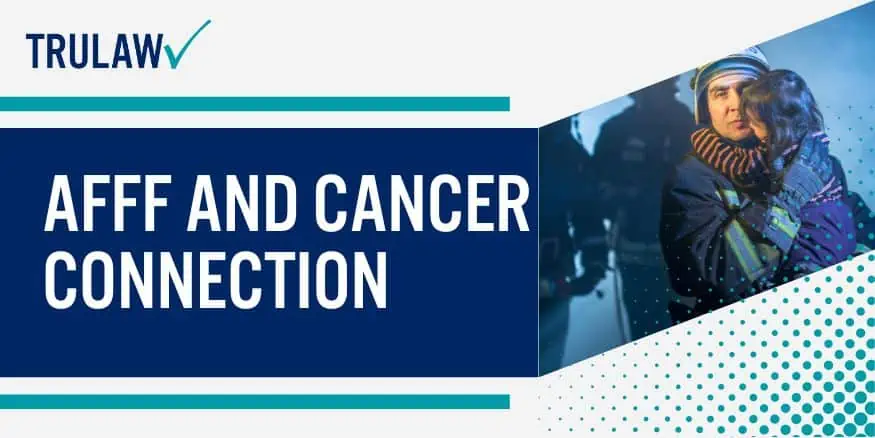
Exploring the link between AFFF exposure and cancer development
AFFF, or aqueous film-forming foam, is a concern in the firefighting community due to the health risks from PFAS contamination.
PFAS are man-made chemicals found in AFFF and can accumulate in the body over time.
Studies suggest a potential link between AFFF exposure and certain cancers in firefighters, but more research is needed and helped by AFFF firefighting foam lawsuit.
PFAS chemicals also have other health effects, like liver damage and immune system dysfunction.
Firefighters should be aware of these risks and take steps to minimize exposure, such as using PFAS-free foams and proper disposal of toxic firefighting foam AFFF.
Understanding the types of cancers associated with AFFF exposure
Several scientific studies have provided valuable insights into the association between AFFF and cancer.
For example, a study conducted by researchers at the Disease Control Institute analyzed data from firefighters who regularly used firefighting foams containing PFAS, including AFFF.
The results showed a higher incidence of kidney cancer among these firefighters compared to those who were not exposed to such foam products.
Another study published in the Journal of Occupational and Environmental Medicine found an increased risk of prostate cancer among firefighters with occupational exposure to firefighting foam containing PFAS, like AFFF.
It is important to note that PFAS chemicals, commonly found in many firefighting foams, including AFFF, can pose a risk to firefighters due to their potential adverse effects on personal health.
These carcinogenic substances raise concerns about the water firefighters use to extinguish fires and the potential for personal injury.
While more research is needed for conclusive evidence, it is crucial for firefighters and individuals working in firefighting professions involving AFFF foam usage to be aware of the potential health risks associated with firefighting and fire suppression.
Regular medical check-ups and monitoring for early signs of cancer can help in the timely diagnosis and treatment of any related medical issues, including PFAS contamination.
Involvement of AFFF Lawyers in Lawsuit
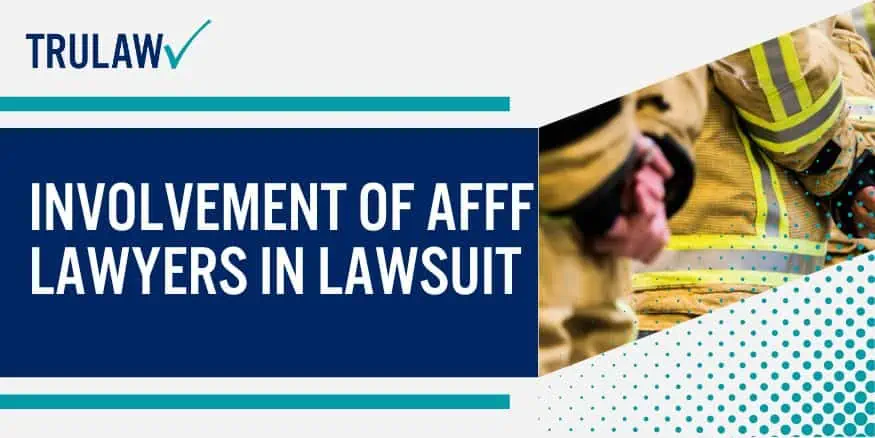
AFFF lawyer represent firefighters affected by AFFF contamination.
They specialize in lawsuits related to the harmful effects of AFFF.
Their goal is to ensure justice and compensation for their firefighter clients.
AFFF contains toxic substances that can cause health issues such as cancer and organ damage.
AFFF lawyer are knowledgeable about the scientific research linking AFFF exposure to health problems.
They gather evidence and consult experts to build strong cases.
Their aim is to hold responsible parties accountable and secure compensation for their clients’ medical expenses, lost wages, and other damages.
Building Strong Cases Against Responsible Parties
Firefighting foam lawsuit lawyers have the main responsibility of gathering evidence and building strong cases against those at fault.
They investigate each case thoroughly, collecting relevant documents, interviewing firefighters, and consulting with fire suppression experts.
This helps them establish a clear connection between their clients’ injuries or damages and the use of AFFF.
In these lawsuits, they often work with firefighters, environmental experts, medical professionals, and other specialists to assess the harm caused by exposure to AFFF chemicals.
Successful Lawsuits Handled by Experienced AFFF Lawyers
One of the key achievements of these AFFF lawyers is securing substantial compensation for victims who have suffered personal injuries due to exposure to firefighting foam chemicals.
Through their diligent efforts, these lawyers have been able to obtain compensation that not only covers medical expenses but also provides financial support for ongoing treatment and recovery.
This financial assistance is crucial in helping affected firefighters cope with the physical, emotional, and financial burdens caused by their exposure to PFAS.
Moreover, AFFF lawyers have been instrumental in holding responsible parties accountable for their actions.
By filing lawsuits and pursuing legal action, these attorneys ensure that companies and organizations involved in the manufacturing, distribution, or use of AFFF are held liable for the harm caused to individuals and communities.
This accountability serves as a deterrent and encourages companies to prioritize the safety and well-being of firefighters and the general public.
The victories achieved by experienced firefighting foam lawyers have not only provided much-needed compensation and accountability but have also raised awareness about the dangers of PFAS exposure in firefighting.
Their expertise in navigating the legal landscape has not only empowered affected firefighters but has also paved the way for future cases seeking justice and compensation for those impacted by PFAS chemicals.
Legal Consultation: What to Expect When Meeting with an AFFF Lawyer
When facing legal issues related to Aqueous Film-Forming Foam (AFFF) contamination and firefighting, it is important to seek professional advice from firefighters or a firefighting lawyer for a legal consultation.
This can provide you with valuable insights and guidance.
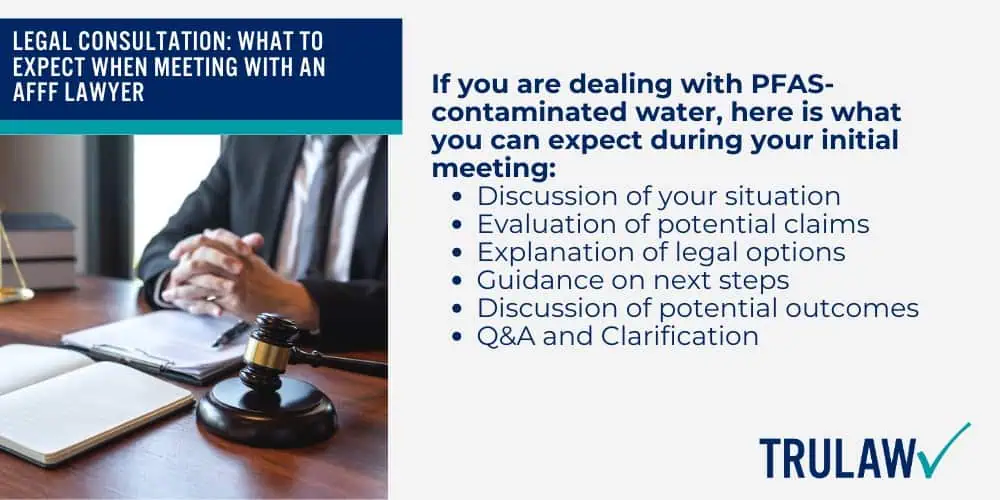
If you are dealing with PFAS-contaminated water, here is what you can expect during your initial meeting:
- Discussion of your situation
- Evaluation of potential claims
- Explanation of legal options
- Guidance on next steps
- Discussion of potential outcomes
- Q&A and Clarification
Discussion of Your Situation
The lawyer will begin by asking you about your specific circumstances and the legal issues you are facing.
They will want to understand the details of your AFFF contamination case and how it relates to firefighting.
Evaluation of Potential Claims
The lawyer will assess the strength of your case and determine if you have grounds for legal action.
They will review any evidence you have and may ask for additional documentation or information.
Explanation of Legal Options
Based on the evaluation of your case, the lawyer will explain the legal options available to you.
They will discuss potential strategies and the likelihood of success for each option.
Guidance on Next Steps
The lawyer will provide guidance on what you should do next.
This may include gathering more evidence, filing a lawsuit, or pursuing alternative dispute resolution methods.
Discussion of Potential Outcomes
The lawyer will discuss the potential outcomes of your case, including the possibility of compensation for damages or other remedies.
They will also explain any potential challenges or risks involved.
Q&A and Clarification
Throughout the meeting, the lawyer will encourage you to ask questions and seek clarification on any points you do not understand.
They will ensure that you have a clear understanding of your legal situation and the steps involved in pursuing your case.
It is important to be open and honest with your lawyer, providing them with all the relevant information to help them assess your case effectively.
Overview of what happens during an initial consultation with an AFFF lawyer
In your initial consultation, the firefighting foam cancer lawyers will gather information about your AFFF firefighting foam lawsuits and evaluate its strengths.
They will inquire about your exposure to AFFF and any related health problems or property damage.
To gain a comprehensive understanding of your trial situation, the law firm attorney may inquire about water et al.
Provide the lawyer with the following information:
- Where you were exposed to AFFF
- How often and for how long you were exposed
- Any medical diagnoses or symptoms you have
- Any documentation or evidence you have
- Any previous legal actions you have taken
This will help the lawyer assess the strength of your AFFF class action lawsuit and determine the compensation you may be entitled to for water contamination.
Importance of providing all relevant information to your attorney during the consultation
In order for the AFFF lawyer to effectively represent you in the PFAS firefighting foam lawsuit trial, it is important to provide them with all relevant information during the consultation.
This includes details about the PFAS, firefighting foam, lawsuits, and trials. Here are some:
- Detailed accounts of your exposure to firefighting foam (AFFF) and its consequences, including potential health risks from PFAS chemicals, are crucial for building a strong case.
- Medical records, test results, and doctor’s diagnoses related to any health issues you have experienced due to the trial, cancer, MDL, or chemicals.
- Photographs or videos showing property damage caused by AFFF contamination from firefighting foam and harmful PFAS chemicals are important evidence for the lawsuit.
- Any correspondence or documentation from responsible parties or insurance companies regarding the use of AFFF firefighting foam, chemicals, and the ongoing trial involving PFAS.
By providing comprehensive details about your trial, MDL, AFFF class action, or AFFF lawsuit, you help the attorney build a strong case on your behalf.
Open communication is key to establishing trust and ensuring a successful attorney-client relationship.
Defense Strategies for AFFF Lawsuits
Common defense tactics used by companies facing AFFF lawsuits.
Companies facing lawsuits related to chemicals like PFAS often employ various defense strategies to protect themselves and mitigate potential liabilities.
These strategies are designed to minimize their legal and financial consequences in AFFF lawsuits.
Some common defense tactics used by companies include, but are not limited to, these five (5) strategies:
- Contractor defense
- Government contractor defense
- Challenging causation
- Statute of limitations
- Assumption of risk
1. Contractor Defense
Companies may argue that they were not directly responsible for the manufacturing or distribution of the AFFF toxic chemicals product in question.
Instead, they may claim that they were acting as contractors or suppliers and should not be held liable for any negative effects of the product.
2. Government Contractor Defense
This defense strategy is often used by companies that have supplied AFFF products to the government or military.
They may argue that they were following specific government specifications and regulations and, therefore, cannot be held responsible for any harm caused by the product.
3. Challenging Causation
Companies may attempt to challenge the link between the AFFF product and the alleged harm caused to individuals or the environment.
They may argue that there is insufficient scientific evidence or that other factors contributed to the harm, thereby attempting to weaken the plaintiffs’ claims.
4. Statute of Limitations
Companies may invoke the statute of limitations defense, which asserts that the lawsuit was filed after the legally prescribed time limit for filing such claims has expired.
This defense aims to dismiss the case based on the argument that it was not timely filed.
5. Assumption of Risk
Companies may argue that the plaintiffs were aware of the potential risks associated with using AFFF products but chose to use them anyway.
By asserting that the plaintiffs willingly assumed the risks, companies aim to reduce their own liability and shift some responsibility onto the plaintiffs.
It is important to note that the effectiveness of these defense strategies can vary depending on the specific circumstances of each case and the strength of the evidence presented by both parties.
How skilled attorneys counter defense strategies to protect their clients’ rights.
Skilled attorneys in AFFF lawsuits use effective strategies to protect their clients’ rights and increase their chances of success.
They gather strong evidence, establish a clear link between AFFF exposure and health issues, challenge defense tactics, and may opt for class action lawsuits to strengthen their case.
Examples of successful defense strategies employed by experienced AFFF lawyers.
Experienced AFFF lawyers or firefighting foam lawyers have effectively fought against defense tactics in PFAS lawsuit cases, using innovative approaches to seek justice for cancer victims.
In a prominent lawsuit against a chemical company accused of producing harmful AFFF products used on military bases, the plaintiffs’ attorney successfully challenged the government contractor’s defense.
They proved that the company did not meet safety standards outlined in its military contract, potentially causing health problems like PFAS-related cancer.
Affording a Firefighting Foam Attorney
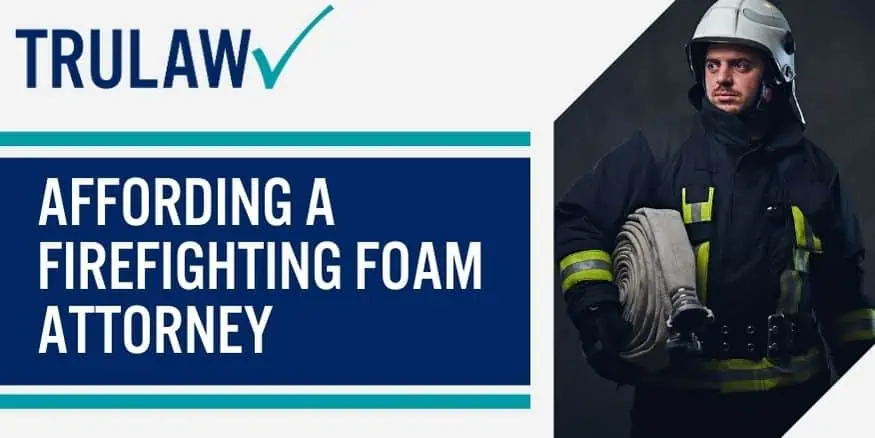
When it comes to pursuing a PFAS cancer lawsuit related to firefighting foam, affording a qualified attorney is essential for plaintiffs seeking justice.
However, the costs associated with such lawsuits can be overwhelming.
Fortunately, there are options available to help individuals overcome financial obstacles and secure the legal representation they need for their PFAS cancer case.
One option for affording a firefighting foam attorney is to seek out law firms that work on a contingency fee basis.
This means that the attorney will only receive payment if they win the case or secure a settlement on behalf of the plaintiff.
This arrangement can be particularly beneficial for individuals who may not have the financial resources to pay for legal representation upfront.
Another option is to explore pro bono legal services.
Many law firms and organizations offer pro bono representation for individuals who cannot afford an attorney.
These services are typically provided free of charge or at a significantly reduced rate.
It’s important to note that pro bono services may have specific eligibility criteria, so it’s essential to research and reach out to organizations that specialize in PFAS cancer cases.
Additionally, some attorneys may be willing to work out a payment plan or offer a reduced fee based on the individual’s financial circumstances.
It’s worth discussing these options with potential attorneys to see if they are willing to accommodate the plaintiff’s financial situation.
In some cases, legal expenses related to a PFAS cancer lawsuit may be covered by insurance.
It’s important to review insurance policies carefully and consult with an attorney to determine if coverage is available.
Lastly, there may be financial assistance programs or grants available specifically for individuals pursuing PFAS cancer lawsuits.
Researching and reaching out to organizations that support individuals affected by PFAS contamination can provide valuable information on potential financial resources.
Contingency Fee Arrangements: A Pathway to Justice
One way to afford a firefighting foam attorney in an AFFF lawsuit is through contingency fee arrangements.
These agreements allow plaintiffs to hire experienced lawyers without upfront payment.
Instead, the attorney’s fees are contingent upon winning the case or securing a settlement, even in cancer cases.
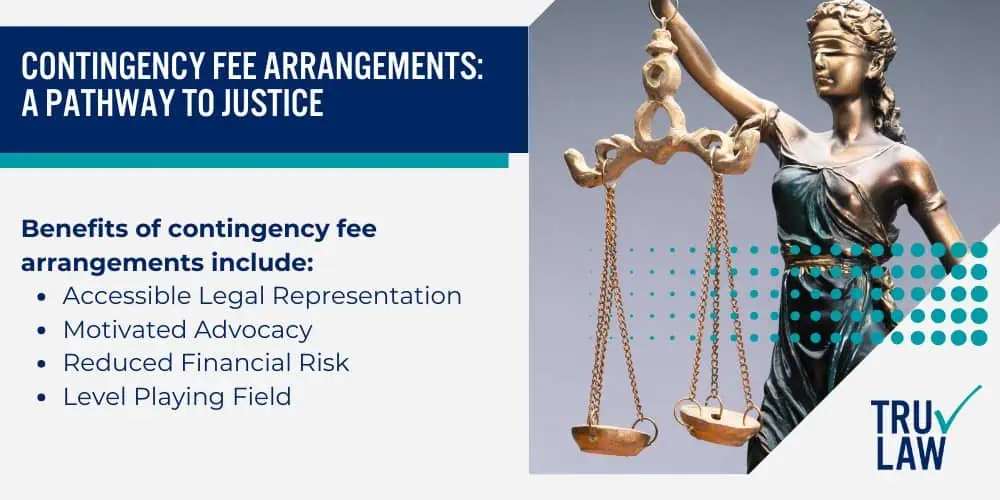
Benefits of contingency fee arrangements include:
- Accessible Legal Representation
- Motivated Advocacy
- Reduced Financial Risk
- Level Playing Field
Accessible Legal Representation
Contingency fees ensure that those affected by the AFFF lawsuit can pursue compensation for harm caused by AFFF firefighting foam containing PFAS.
Motivated Advocacy
Attorneys only get paid if they win the AFFF lawsuit or secure a settlement related to AFFF firefighting foam, so they are highly motivated to provide effective representation in cancer cases caused by PFAS.
Reduced Financial Risk
Plaintiffs don’t have to pay attorney fees if their case involving PFAS and AFFF firefighting foam is unsuccessful, only responsible for lawsuit expenses.
Level Playing Field
Contingency fees level the playing field for individuals affected by the AFFF lawsuit and PFAS exposure, allowing them to stand up against powerful entities responsible for their suffering due to AFFF firefighting foam and increased cancer risk.
Financial Assistance Resources
Besides contingency fee arrangements, there are resources and organizations that offer financial assistance specifically for covering legal fees in firefighting foam cases, like AFFF lawsuits involving PFAS and cancer.
These resources provide valuable support and help ease the financial burdens of seeking justice in these cases.
Some options for financial assistance include legal aid organizations, legal expense insurance, and litigation funding.
By considering these options, plaintiffs can afford experienced lawyers for their AFFF lawsuit and pursue their cases without financial strain.
Scientific Testing on AFFF and PFAS Toxicity
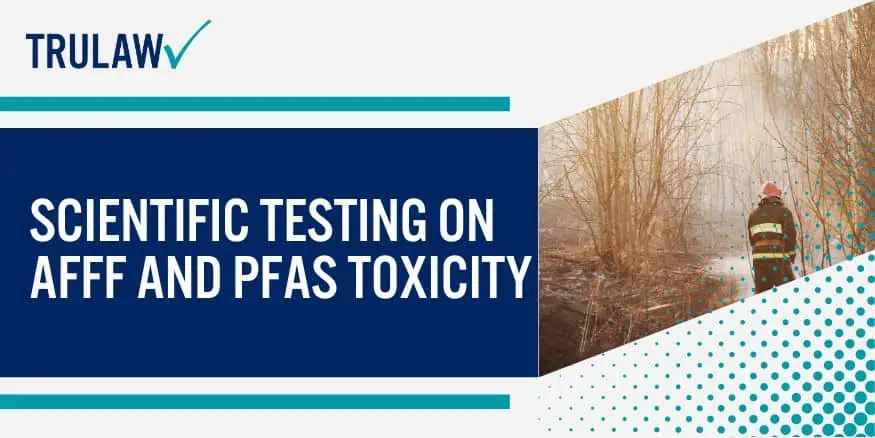
Scientific studies have extensively examined the toxicity of polyfluoroalkyl substances (PFAS) chemicals found in firefighting foams like aqueous film-forming foams (AFFFs).
These studies have a specific goal of understanding the potential health risks associated with PFAS exposure, particularly the risk of developing cancer.
Additionally, these studies aim to shed light on the long-term effects of PFAS exposure, which may lead to legal actions and lawsuits.
Laboratory tests have yielded concerning results regarding the dangers of PFAS chemicals, including AFFF firefighting foam.
Exposure to certain PFAS, such as AFFF, has been linked to various health issues, including reproductive problems, liver damage, immune system dysfunction, and an increased risk of cancer.
The scientific evidence gathered from these tests underscores the urgent need for action to address PFAS contamination and the ongoing lawsuits related to AFFF.
The Environmental Protection Agency (EPA) has played a crucial role in overseeing test trials and research efforts related to firefighting foam (AFFF) and PFAS exposure.
Their findings have highlighted the severity of water contamination caused by these toxic chemicals, which has resulted in an increase in lawsuit cases.
Municipal water contamination cases across the country further emphasize the pressing need for comprehensive regulation and remediation measures to address the cancer risks associated with AFFF and PFAS.
More to Consider
PFAS, like AFFF firefighting foam, are called “forever chemicals” because they don’t break down easily and can accumulate in the environment and human bodies.
Even small amounts of exposure to AFFF firefighting foam can have long-lasting adverse effects, such as cancer.
Ongoing research aims to understand how these chemicals cause harm, including cancer, at a molecular level.
This knowledge can help develop strategies to protect public health and address potential lawsuits.
Collaboration between scientists, policymakers, organizations, and affected communities is crucial in addressing the urgent issue of PFAS contamination caused by AFFF firefighting foam.
Some individuals may consider filing an AFFF lawsuit due to the health risks associated with PFAS exposure, including cancer.
Latest Updates on AFFF Class Action Lawsuits
Recent Developments in AFFF Contamination Lawsuits
In the ongoing AFFF class action lawsuits regarding Aqueous Film-Forming Foam (AFFF) contamination, there have been important updates on PFAS and cancer.
Plaintiffs in different areas are seeking justice for the harm caused by this firefighting foam, and recent developments show progress in addressing the concerns.
A significant development is the increase in new cases related to firefighting foam.
In the past month, there has been a surge in filings as more affected individuals come forward.
These lawsuits join the growing number of class actions seeking compensation for health issues, including cancer, and property damage from exposure to AFFF and PFAS.
Notable Settlements and Verdicts in AFFF Cases
Recent progress in firefighting foam class action lawsuits has resulted in notable settlements and verdicts.
Defendants involved in the manufacturing or distribution of AFFF products containing PFAS, which are linked to cancer, have faced legal consequences in various jurisdictions.
For example, a major settlement was reached last week with a leading manufacturer of AFFF foam in a firefighting lawsuit.
This settlement exceeded expectations and provided substantial compensation to affected individuals and communities.
It not only offers financial relief but also sends a powerful message that companies responsible for producing harmful substances like PFAS will be held accountable for the increased cancer risk.
Additionally, recent jury verdicts in favor of plaintiffs in AFFF lawsuits have demonstrated the strength of these cases.
Jurors recognize the impact of AFFF and PFAS exposure on people’s lives, potentially leading to cancer, and have awarded significant damages.
These verdicts serve as a deterrent to other defendants who may disregard public safety when dealing with hazardous substances like AFFF.
Legislative Actions and Regulatory Measures Addressing AFFF Issues
Legislative actions are being taken to address concerns about firefighting foam contamination and its potential link to cancer-causing PFAS chemicals.
Some states are introducing bills to ban or restrict the use of these hazardous foams, while regulatory agencies are revisiting safety standards.
Multidistrict litigation has also been established to streamline lawsuits and ensure consistent rulings.
These developments are helping to hold responsible parties accountable and seek compensation for those affected by contamination.
Recovering Compensation in AFFF Lawsuit Settlements
Types of compensation available for individuals affected by AFFF contamination
If you have been adversely impacted by Aqueous Film-Forming Foam (AFFF) contamination, such as firefighting professionals who are at a higher risk of exposure to PFAS, you may be eligible to seek financial compensation through an AFFF lawsuit settlement.
These settlements aim to provide relief and support to those who have suffered due to exposure to the harmful substance, which has been linked to serious health issues, including cancer.
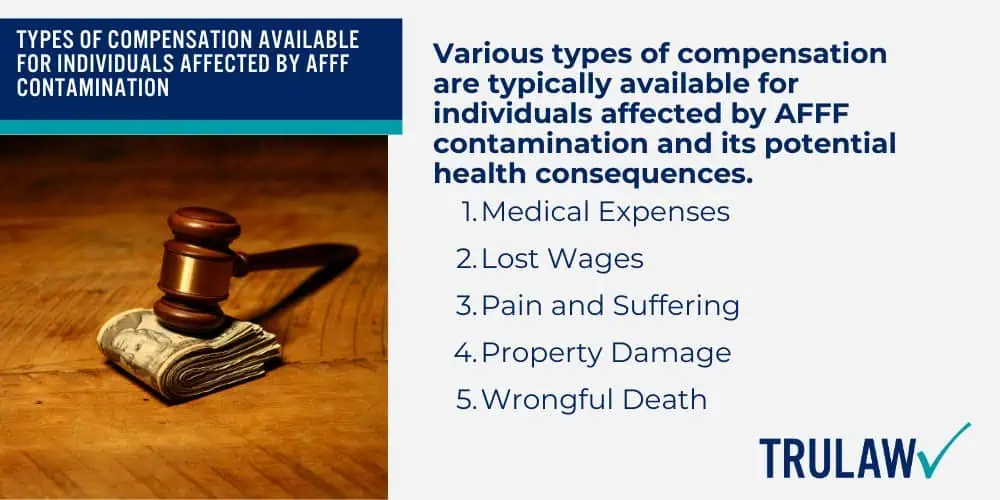
Various types of compensation are typically available for individuals affected by AFFF contamination and its potential health consequences.
- Medical Expenses: Compensation may cover the costs associated with medical treatment, including hospital bills, doctor visits, medications, and ongoing therapies required as a result of exposure to AFFF.
- Lost Wages: If your health condition caused by AFFF contamination has resulted in missed workdays or reduced earning capacity, you may be entitled to compensation for lost wages and future income loss.
- Pain and Suffering: Compensation can also account for the physical pain, emotional distress, and diminished quality of life experienced as a result of the harm caused by AFFF exposure.
- Property Damage: In cases where the property has been damaged or destroyed due to AFFF contamination, individuals may seek reimbursement for repair or replacement costs.
- Wrongful Death: In tragic cases where a loved one has passed away due to complications related to AFFF exposure, surviving family members may pursue compensation through a wrongful death claim.
Factors considered when determining the amount of compensation in an AFFF lawsuit settlement.
When negotiating a firefighting foam (AFFF) lawsuit settlement involving PFAS contamination, several factors come into play when determining the amount of compensation that should be awarded for cancer cases.
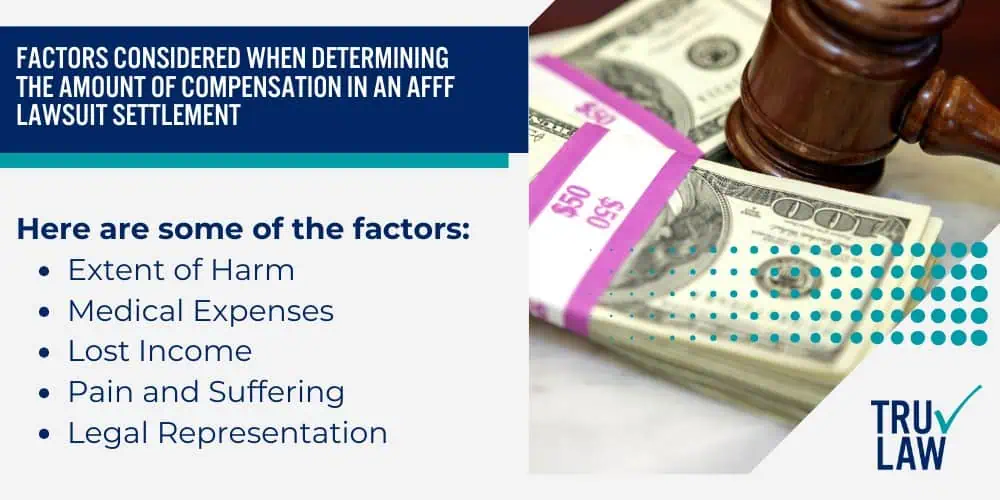
Here are some of the factors:
- Extent of Harm
- Medical Expenses
- Lost Income
- Pain and Suffering
- Legal Representation
Extent of Harm
The severity of health issues suffered by the individual is a significant factor in calculating compensation amounts.
This includes considering both immediate effects and long-term consequences resulting from exposure to AFFF chemicals.
Medical Expenses
The total cost incurred for medical treatments directly related to AFFF contamination is taken into account.
This includes past, present, and future medical expenses.
Lost Income
Compensation may be awarded for the income lost due to missed workdays or reduced earning capacity caused by health issues resulting from AFFF exposure.
Pain and Suffering
The physical and emotional distress endured by the affected individual is evaluated when determining compensation.
This includes considering the impact on overall quality of life.
Legal Representation
Experienced AFFF lawyers play a crucial role in negotiating settlements on behalf of their clients.
Their expertise and ability to present a strong case can significantly influence the amount of compensation secured.
How experienced AFFF lawyers negotiate with defendants to secure fair compensation for their clients.
Experienced AFFF lawyers are skilled negotiators who secure fair compensation for their clients in lawsuit settlements.
They assess each client’s circumstances, including harm suffered, medical records, and financial losses, to strengthen their case.
They also prepare a comprehensive demand package outlining their client’s losses, such as medical expenses, lost wages, and property damage, caused by AFFF contamination.
Conclusion: AFFF and Cancer Connection
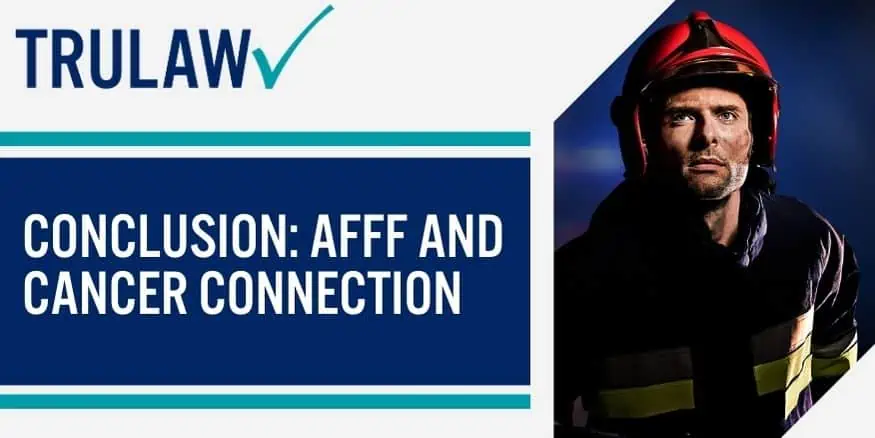
If you or a loved one has been affected by AFFF exposure, it’s important to get help from an experienced AFFF lawyer.
These lawyers specialize in handling cases related to AFFF and can guide you through the legal process.
They will assess your case, explain your rights, discuss compensation options, and outline the steps involved in pursuing a lawsuit.
AFFF lawsuits require different defense strategies for each case.
Experienced lawyers use tactics like gathering evidence, conducting scientific tests, consulting experts, and staying updated on class action lawsuits related to AFFF to build a strong case against those responsible for your suffering.
Affording an AFFF lawyer shouldn’t be a barrier to seeking justice.
Many lawyers work on a contingency fee basis, meaning they only get paid if they win your case and secure compensation for you.
This ensures that anyone can have access to quality legal representation, regardless of their financial situation.
Scientific testing continues to reveal the toxicity of AFFF and its main component, PFAS.
These studies help establish the link between AFFF exposure and adverse health effects like cancer.
Staying informed about these findings can strengthen your case with compelling evidence.
Lastly, staying updated on AFFF class action lawsuits can provide valuable insights into successful compensation strategies.
By staying informed, you can make informed decisions and take appropriate action to protect your rights..
AFFF Lawsuit Frequently Asked Questions
-
Several crucial factors are considered when calculating compensation for individuals affected by PFAS contamination through firefighting foam (AFFF).
These include the severity of health issues caused by the exposure, incurred medical expenses, lost income due to health-related work limitations, and the physical and emotional suffering experienced by the individual.
-
The severity of health issues is pivotal in determining the compensation amount in an AFFF lawsuit settlement.
This involves assessing both the immediate effects and the long-term consequences resulting from exposure to AFFF chemicals.
The more serious and enduring the health impact, the higher the potential compensation may be.
-
Compensation settlements take into account the full spectrum of medical expenses related to AFFF contamination.
This includes not only the current medical costs but also past expenses and anticipated future medical treatments.
The goal is to provide a comprehensive compensation package that addresses the financial burden caused by the exposure.
-
Lost income resulting from missed workdays or reduced earning capacity due to health issues caused by AFFF exposure is considered when determining compensation.
Individuals who experience work limitations or are unable to earn their regular income due to health problems related to AFFF contamination may be eligible for compensation that covers these financial losses.

Managing Attorney & Owner
With over 25 years of legal experience, Jessica Paluch-Hoerman is an Illinois lawyer, a CPA, and a mother of three. She spent the first decade of her career working as an international tax attorney at Deloitte.
In 2009, Jessie co-founded her own law firm with her husband – which has scaled to over 30 employees since its conception.
In 2016, Jessie founded TruLaw, which allows her to collaborate with attorneys and legal experts across the United States on a daily basis. This hypervaluable network of experts is what enables her to share the most reliable, accurate, and up-to-date legal information with our readers!
Additional AFFF Lawsuit resources on our website:
Here, at TruLaw, we’re committed to helping victims get the justice they deserve.
Alongside our partner law firms, we have successfully collected over $3 Billion in verdicts and settlements on behalf of injured individuals.
Would you like our help?
At TruLaw, we fiercely combat corporations that endanger individuals’ well-being. If you’ve suffered injuries and believe these well-funded entities should be held accountable, we’re here for you.
With TruLaw, you gain access to successful and seasoned lawyers who maximize your chances of success. Our lawyers invest in you—they do not receive a dime until your lawsuit reaches a successful resolution!
AFFF Lawsuit claims are being filed against manufacturers of aqueous film-forming foam (AFFF), commonly used in firefighting.
Claims allege that companies such as 3M, DuPont, and Tyco Fire Products failed to adequately warn users about the potential dangers of AFFF exposure — including increased risks of various cancers and diseases.
Depo Provera Lawsuit claims are being filed by individuals who allege they developed meningioma (a type of brain tumor) after receiving Depo-Provera birth control injections.
A 2024 study found that women using Depo-Provera for at least 1 year are five times more likely to develop meningioma brain tumors compared to those not using the drug.
Suboxone Tooth Decay Lawsuit claims are being filed against Indivior, the manufacturer of Suboxone, a medication used to treat opioid addiction.
Claims allege that Indivior failed to adequately warn users about the potential dangers of severe tooth decay and dental injuries associated with Suboxone’s sublingual film version.
Social Media Harm Lawsuits are being filed against social media companies for allegedly causing mental health issues in children and teens.
Claims allege that companies like Meta, Google, ByteDance, and Snap designed addictive platforms that led to anxiety, depression, and other mental health issues without adequately warning users or parents.
Transvaginal Mesh Lawsuits are being filed against manufacturers of transvaginal mesh products used to treat pelvic organ prolapse (POP) and stress urinary incontinence (SUI).
Claims allege that companies like Ethicon, C.R. Bard, and Boston Scientific failed to adequately warn about potential dangers — including erosion, pain, and infection.
Bair Hugger Warming Blanket Lawsuits involve claims against 3M — alleging their surgical warming blankets caused severe infections and complications (particularly in hip and knee replacement surgeries).
Plaintiffs claim 3M failed to warn about potential risks — despite knowing about increased risk of deep joint infections since 2011.
Baby Formula NEC Lawsuit claims are being filed against manufacturers of cow’s milk-based baby formula products.
Claims allege that companies like Abbott Laboratories (Similac) and Mead Johnson & Company (Enfamil) failed to warn about the increased risk of necrotizing enterocolitis (NEC) in premature infants.
Here, at TruLaw, we’re committed to helping victims get the justice they deserve.
Alongside our partner law firms, we have successfully collected over $3 Billion in verdicts and settlements on behalf of injured individuals.
Would you like our help?
